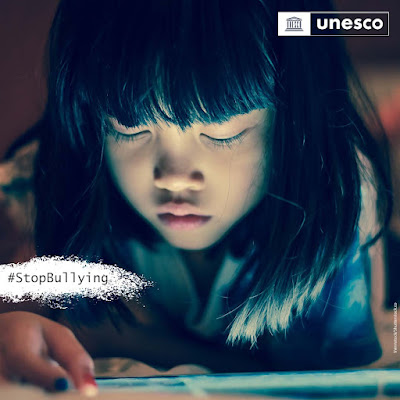School violence and bullying including cyberbullying is widespread and affects a significant number of children and adolescents.
Bullying, including cyberbullying, can have serious impacts on children’s mental health & well-being.
5 November 2020 marked the first-ever celebration of the new International Day against Violence and Bullying at School including Cyberbullying, under the theme “Together against Bullying in school”.
This year, the International Day on Thursday 4 November 2021 will be under the theme:
“Tackling cyberbullying and other forms of online violence involving children and young people”.
As countries are responding to COVID-19 at varying stages, the lives and education of children and young people across the world have increasingly moved online. For example, compared to the prior year, children’s screen time had doubled in the USA by May 2020, and while online access presents opportunities for connection and learning, it is also increasingly putting children and young people at the risk of online violence.
Did cyberbullying increase during COVID-19? Sadly...Yes. Almost 50% of surveyed children in 11 European countries who were cyberbullied before lockdown said it had only increased during 2020. Here's what you need know:
Although global data is limited, evidence shows that cyberbullying has been on the rise in various regions during the pandemic. In Europe, 44% of children who were cyberbullied prior to COVID-19 reported that it had increased during lockdown. Data from several countries also reveals that children, in particular girls at the age of 11 to 13 years, are increasingly at risk of being targeted by criminal sex predators. In the USA, 98% of online predators have never met their targets in real life.
"The lockdown affecting most European countries in spring 2020 saw the sudden shift of most children's activities into the digital world. Since then, children's schooling, leisure time, social contacts, home life have mostly been conducted at home via digital media. Embracing new tools and services and spending several hours per day online changed dramatically daily schedules. The online world offers opportunities and new possibilities, substituting face-to-face interactions. However, it opens the door to well-known online risks (inappropriate content, overuse, cyberbullying, cyberhate, disinformation, misuse of personal data, cyber-risks, etc.)"
in "How children (10-18) experienced online risks during the Covid-19 lockdown - Spring 2020", JRC Publications Repository
Disorders & consequences.
The consequences of violence and bullying at school including cyberbullying are far-reaching. This includes children and youth finding it difficult to concentrate in class, missing classes, avoiding school activities, playing truant or dropping out of school altogether. This has an adverse impact on academic achievement and future education and employment prospects. An atmosphere of anxiety, fear and insecurity is incompatible with learning and unsafe learning environments can undermine the quality of education for all learners.
"Too many people think bullying at school including cyberbullying is an inevitable rite of passage to adulthood and that is relatively harmless and one can do little to stop it. Instead, there is strong evidence that violence and bullying at school including cyberbullying can be prevented, and effectively addressed if it happens."
UNESCO
- Parents:
- Teachers:
- My thoughts:
Kids and young adolescents do need to be reminded that not everyone they meet in school or online is who they say they are. As parents, you might wonder whether what they are doing is safe or not.










No comments:
Post a Comment